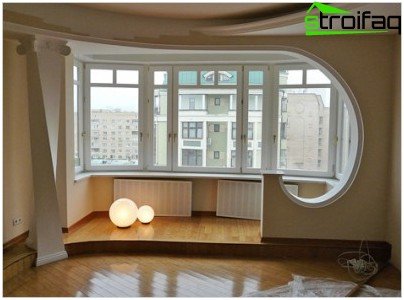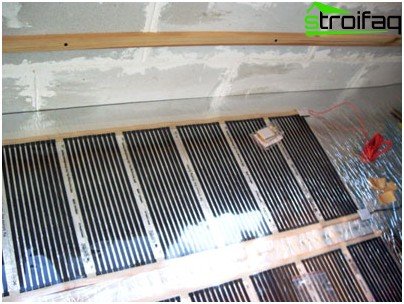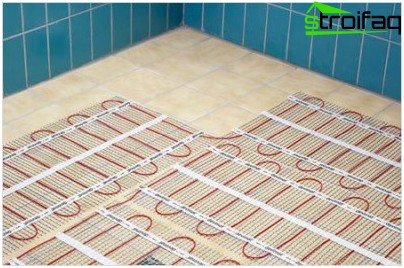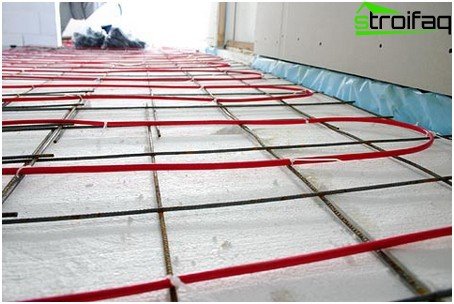Warm floor on the balcony
The issue of expanding the living space has always been and remains relevant for most of our citizens, because everyone wants to have their own corner, where they could be secluded, where it is always warm and cozy. You can create coziness and comfort in your own home in a variety of ways, one of which is the insulation of a living room. Of particular relevance is now acquired underfloor heating. So, the warm floor on the balcony provides many opportunities to create the desired coziness.
Content
- Reasons for the installation of a heated floor on the balcony
- Types of underfloor heating for balconies and loggias
- Infrared film floors
- Heating mats: pros and cons
- Cable Floor Heating Systems
Reasons for the installation of a heated floor on the balcony
Today, ideas of combining bedrooms, kitchens and living rooms with balconies or loggias have become more widespread. Often, with a sufficiently large area, balconies can be easily converted into an office or a winter garden.

When expanding living space due to the balcony, you have to carefully consider options for additional heating for this zone
In such cases, the new room needs additional heating. As a rule, the heat from the central heating battery is simply not enough, and the question arises of additional heating of the room. The floors in the loggias and on the balconies are usually much colder than the floors in the apartments. This is especially noticeable in the cold winter.
The most convenient, modern and affordable solution to this problem will be the installation of underfloor heating on the balcony.
Types of underfloor heating for balconies and loggias
For loggia insulation or a balcony, only electric underfloor heating systems are used, which include:
- Cable heating systems that can play the role of both an additional floor heating system and the main room heating system (single-core or two-core heating sections).
- Special heating mats.
- Infrared floors (film) – a special system of floor heating based on far infrared radiation.
Infrared film floors
In addition to heating mats, infrared film floors are used for additional heating of the balcony, the principle of which is the radiation of the long-wave thermal component of the rays of the solar spectrum. That is, heat rays underlie infrared heating.

Infrared film floors
During the operation of the system, the rays heat the room completely: not only the floor covering, but also the walls, interior items, which, giving off secondary heat, form the most comfortable temperature in the room where there is no way to heat the air. One of the main advantages of infrared film floors is their compatibility with absolutely any finishing floor covering, be it linoleum, parquet, tile or carpet.
Heating mats: pros and cons
The advantage of heating mats is that they can be mounted directly into the adhesive itself, which strengthens the tiles.
In order to lay such mats, you need a leveling layer, ceramic coating or concrete base. Immediately after the adhesive has hardened, you can proceed with the installation of warm floors.

Warm floor on the balcony: heating mats
The disadvantage of such a system is a considerable risk of subjecting it to mechanical damage during the installation of flooring, as well as when moving the working material. Damage is also possible as a result of the fall of any heavy object on it. In addition, a considerable disadvantage of heating mats is their inability to retain heat. This leads to the fact that you can use heating mats only as an additional source of heat.
Cable Floor Heating Systems
Both single-core and two-core cable sections are mounted only together with a cement-sand screed. In this case, a mandatory element is the presence of a layer of waterproofing and high-quality insulation, the absence of which will certainly lead to the loss of most of the heat directed downward. In this case, the ceiling of the neighbor will be heated from below..

Cable floor heating system on the balcony
The layer of cement-sand screed to be installed must have a thickness of at least 45 mm. In addition, it should not have a single air gap. The main heating cable is placed in the screed to a depth of at least 30 mm. The best heat conductor among finishing finishing materials, which are a coating of a warm floor, is tile. On this floor it is quite possible to walk barefoot, and for people with poor health, children and the elderly, a parquet board is ideal as a finishing coating. After installing this type of underfloor heating system, it is necessary to wait for the final screed to solidify, which will occur in about 28 days. Only after this the warm floors will be suitable for normal use. In the case when laying a warm floor using a cement-sand screed is inappropriate, for example, due to the inability to achieve a sufficient thickness of 45 mm, heating mats are used to install the warm floor system.
Thus, at present, warm floors are perfectly acting both as the main and as an additional source of heating not only for the flooring itself, but also for the entire room of the balcony or loggia as a whole, creating always a comfortable and cozy atmosphere. In such a room it is always pleasant not only to enter yourself, but also to have guests proudly.





